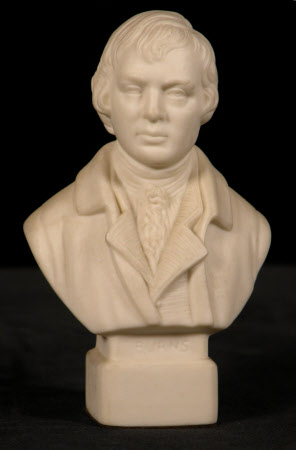Portrait bust of Robert Burns (1759-1796)
Robinson and Leadbeater Ltd (fl.1864-1924)
Category
Art / Sculpture
Date
c. 1875 - 1920
Materials
Parian
Measurements
125 mm (H)
Place of origin
Hanley
Order this imageCollection
Cragside, Northumberland
NT 1231019.1
Summary
Ceramic sculpture, Parian ware; Robert Burns (1759-1796); Robinson and Leadbeater; c. 1875-1900. A small Parian ware bust of the great Scottish poet Robert Burns, formerly paired with a bust of Sir Walter Scott, stolen in April 2009.
Full description
A Parian ware sculpted bust of the Scottish poet Robert Burns (1759-1796), manufactured by Robinson and Leadbeater. Burns is depicted facing forward, dressed in a jacket and coat and with a stock at his neck. On the pedestal ‘BURNS’ and on the back the Robinson and Leadbeater stamp. Robinson and Leadbeater was one of a number of firms in Stoke-on-Trent that capitalised on the nineteenth-century fashion for small sculptures made from so-called Parian ware, a ceramic material, somewhat like biscuit porcelain, that approximated to the appearance and texture of marble. Whereas companies like Copeland marketed Parian ware alongside its more extensive ranges of domestic ceramics, Robinson and Leadbeater was unusual in that it concentrated very largely on the production of Parian. It was established in Hanley in the early 1860s and soon became one of the largest manufacturers of Parian, with strong domestic and export markets. The company, which was noted for the quality of its products, continued in business until 1924. As well as statuettes, Robinson and Leadbeater made a long series of portrait busts to a more or less standard small size, depicting notable personalities from historical to modern times. Many, such as the bust of Burns, had small integral bases. It formerly had as its pair a portrait of another great Scottish literary figure, Sir Walter Scott, which was stolen in 2009 (NT 1231019.2). The R&L stamp on the bask of the bust began to be used by the company to mark its products from the mid-1870s onwards. Jeremy Warren March 2022
Provenance
Armstrong collection. Transferred by the Treasury to The National Trust in 1977 via the National Land Fund, aided by 3rd Baron Armstrong of Bamburgh and Cragside (1919 - 1987).
Makers and roles
Robinson and Leadbeater Ltd (fl.1864-1924), manufacturer
References
Atterbury, 1989: Paul Atterbury &c, The Parian Phenomenon. A Survey of Victorian Parian Porcelain statuary and busts, Somerset, 1989, p. 235, fig. 772.
